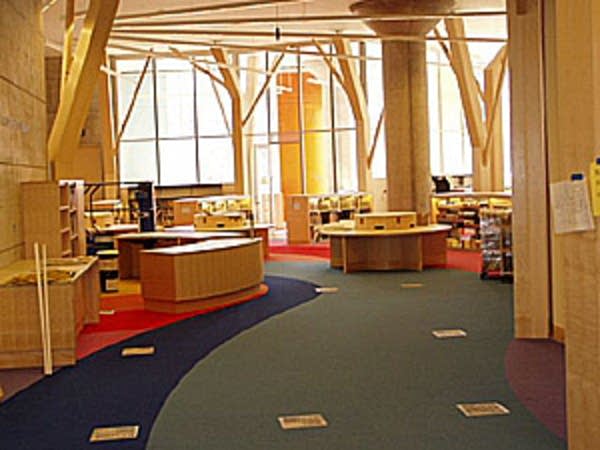A sneak peek at the new Central Library

The new building sits on the same land as the old library. But it cuts a considerably different profile from its predecessor. Designed by Connecticut-based architect Cesar Pelli, the new library is wrapped in glass, rather than brick.
"I've heard all kinds of explanations or analogies of what this structure reminds people of, but one thing I like to think of it as of an open book," says library spokeswoman Karen Louise Boothe. She stands in the atrium of the building, called library commons, and looks skyward to the underside of the library's most dramatic feature--a 90-ton beam they call a cantilever.

It looks like a giant aircraft wing.
"And the cantilever, which has been getting a lot of architectural attention--this rooftop that juts out over Nicollet Mall sidewalk and Hennepin Avenue sidewalk--to me is almost reminiscent of a bookmark," she says.
Create a More Connected Minnesota
MPR News is your trusted resource for the news you need. With your support, MPR News brings accessible, courageous journalism and authentic conversation to everyone - free of paywalls and barriers. Your gift makes a difference.
There's a lot to see in the new library. From the bright red, curving bookshelves of Teen Central, to the forest-like children's library, the numerous public art installations and fireplaces. And there are books and other reference materials --over 3 million of them, spread over four floors.
How to make that accessible to users presents a unique challenge.
"One of the things we decided early on is that, to the extent possible, we want people to serve themselves and help themselves and find things readily and make our technology as user-friendly and as accessible as we can," says Betsy Williams, the library's director of collection and technical services.
For example when you enter the library commons area, you'll see kiosks with large monitors. You'll be able to find which floor contains the materials you're looking for by touching the screen. You can find more detailed information by touching smaller screens located on each floor.

Once you find what you're looking for, you'll also be able to check out materials with one of eight self-check-out stations.
Williams says technology will also make the process of checking in and reshelving books easier for library staff.
"There's automated equipment for the public so they can actually return their own materials through the system, which will immediately feed the materials onto a conveyor belt and into a sorted bin that will allow us to just take the truck once it's full and shelve the materials," says Williams. "So it eliminates many, multiple steps of sorting material for shelving purposes."
The system, developed by a Danish company, can sort 6,000 items per hour. Williams says that will free up time for library staff to interact more with library patrons.
The other big technological feature of the new library involves computers and internet access. There will be nearly 300 public computers, three times the number of the old library. Each will have access to the internet at speeds much faster than most commercial service providers. The library will also offer free broadband wireless access inside the building. So you can bring your wireless-equipped laptop and surf the web using the library's network.
The library's IT director, Sharon Kinsmith, says planning began three years ago. But they waited until last year to decide what kind of wireless and computer technology to use.
"The technology changes pretty much monthly," she says. "Which is a big challenge for us, with as many public computers as we have because pretty much every month there's an update to something and a change to some program or some new program becomes available."
Kinsmith says the library is still shopping for programs designed to help hearing- and sight-impaired computer users. And the public computers aren't scheduled to be delivered until next month. However, she says they will be ready for opening day on May 20, 2006.
Library officials say they're expecting 20,000 people to show up.
